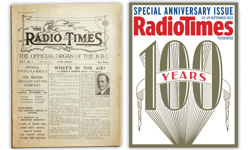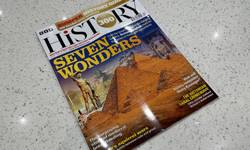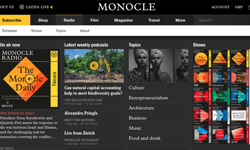And it’s the sort of problem the PPA has landed itself with in the laudable attempt to mark its 100th anniversary by establishing the magazine Cover of the Century. Over 100 of its 220 members responded to the invitation to submit up to three nominations each for the title.
In February, a panel of industry elders (ex-CEOs, ex-editors, ex-art directors under the chairmanship of the PPA’s Barry McIlheney) reduced the subsequent mass of entries to a shortlist of ten - Beano, Cosmopolitan, Empire, Harper’s Bazaar, MacUser, New Scientist, Radio Times, TimeOut, Vogue and Woman’s Weekly. These covers are posted on the PPA website with an invitation for the general public to vote for an overall winner. Many thousands have already done so and (with the advice that you can vote every day until September 30) numbers will have soared by the time the Cover of the Century is announced on November 21 – the 100th anniversary date of the founding of the PPA in 1913.
So far so good. The only snag is that the elders were clearly not old enough to be familiar with a whole century of covers. All ten of the shortlist are titles still with us. Only two of the chosen covers are dated earlier than 1942; one was on display only last year. Many great magazines of the past are missing as large tracts of the century go unrepresented.
I have no quarrel with the panel’s shortlist as a well varied selection of successful cover designs. Each would have given a powerful sell to its particular issue. But surely the Cover of the Century has to be of more significance than its sales appeal in a particular week or month (or, in one case, boasting an audio gimmick). All but three of the contenders are near enough sufficiently contemporary in style to be appearing on the newsstand this week.
Successful magazines reflect the moods, the values, the very texture of their society. Any claim to be the Cover of the Century must stem from a title which most effectively encapsulates those values within the context of its own times. And a proper choice can only be made by providing the voter with a cavalcade of covers representing the constantly changing face of the magazine industry across the whole of the 100 years we are celebrating.
Several of the PPA entries are certainly qualified to be doing just that but only if placed chronologically in a decade-by-decade run through the century. I have chosen to summon up some memorable titles to fill in the gaps.
It’s worth remembering that magazines had been around for more than two centuries before 199 periodicals got together to form the PPA in 1913. First magazine on record was The Ladies Mercury of 1693 which carried sketches of the latest Paris fashions so its wealthy readers could get them copied by their personal dressmakers and so dazzle London society with Gallic chic.
The very term, magazine, is thought to stem from the French magasin meaning shop. From the very beginning, readers of women’s magazines were shopping for ideas. Plus ça change!
The Tatler came along in 1709 as more of a journal of gossip and, overlooking a two-year break in the 1960s, can claim to be our oldest surviving title.
Throughout the 18th and 19th centuries, magazines were aimed largely at the upper classes since some were priced at as much as a shilling (nearly £4 at today’s values). It was not until the autumn of 19ll, that a certain magazine went for the mass market with a price of just one penny. That was Woman’s Weekly.
Still with us today and still the biggest selling of IPC’s traditional women’s weeklies, who better to kick off a century of covers that counted?
The Early Years: Woman’s Weekly
A World War One cover of heart-rending sentimentality, the little woman on the home front urging her son to be worthy of the father lost in the trenches. This mood of unquestioning patriotism endured the slaughters of the battlefront and played a large part in maintaining the morale of the female population left behind.
The Twenties: Good Housekeeping
Seen to be the first of the middle-class “service” magazines, Good Housekeeping was launched in March 1922, and found a ready market in better-off folk wanting help and guidance through the gradual disappearance of the domestic staff such households enjoyed before the war. Priced at one shilling, it rocketed to sales of over 150,000, achieving a density of advertising pages hitherto unknown. Like much more modest Woman’s Weekly, its launch cover showed that sentimentality was still the big seller of the day. And like Woman’s Weekly, it is still the brand-leader of its sector.
The Thirties: Picture Post
Two leaping cowgirls against a clear sky. No caption anywhere, the girls are not identified, the photographer’s not credited. It’s a blatantly show-off picture, demonstrating that here’s a new magazine that knows about high-speed shutters and fast film and as for content, well, anything goes. Thus Picture Post burst upon the scene in October 1938. With war looming, proprietor Edward Hulton wanted a show of force on the cover with battleships steaming in line ahead but editor Stefan Lorant ignored his proprietor and used this joyous image. The age of photo-journalism had begun.
The Forties: Harper’s Bazaar
Harper’s Bazaar makes a bid to lighten the gloom in the bleakest days of the Blitz by showing barrage balloons keeping watch over St Paul’s Cathedral in a fantasy fashion shoot that might have been styled by Salvador Dali. But while the industry stagnated with paper strictly rationed and a lack of consumer goods seeking advertising, vast social changes were taking place that would create a pent-up demand for magazines when peace came.
The Fifties: John Bull
Folksy illustrations still had a place on the covers of best-selling titles. John Bull – something of a scandal sheet when published by the notorious Horatio Bottomley at the end of World War One - came out of the Second World War as a million-selling weekly catering for a middlebrow family audience eager to devour serialisations of best-selling authors such as Agatha Christie, H E Bates and C S Forester. Unfortunately, that appetite was to collapse in 1964 when TV was providing more compulsive fiction in the form of soap operas.
The Sixties: Nova
A period of ferment for the magazine business with a stampede of launch titles trying to cash in on the billion-pounds-a-year spending power of the new mini-skirted teenager. But there was an explosion of graphic design as other publishers went for the more sophisticated female market. Town magazine, then Queen and the Sunday Times Magazine, as the first of the colour supplements, all began to project images in a way never seen before. And from all this emerged Nova – “The New Magazine for the New Woman” – discussing sexual matters in disturbingly frank language along with stark, unconventional images. But after its shock impact it became increasingly worthy on social matters and eventually gave way to the brash Cosmopolitan.
The Seventies: TimeOut
Considering the fierce backlash against the relatively mild dissension at the ceremonial funeral of Lady Thatcher – the most controversial of all prime ministers – easily the bravest cover of the century must be TimeOut sticking up two fingers to the memory of the man deified as the wartime saviour of the nation, Winston Churchill. Much more than a mere listings title, TimeOut was unashamedly the underground voice of urban youth.
The Eighties: New Scientist
Respected by the world-wide scientific community for its authoritative content, New Scientist consistently comes up with covers that leap from the newsstand and gain it a popular readership unique in this area of publishing. Its Chernobyl coverage shows how an artwork cover can embrace a major issue more comprehensively than any single image caught on film.
Into The New Millennium: Vogue
Who better to hail the new millennium than Vogue, nonchalantly arrogant arbiter of high fashion, rarely challenged since its improbable launch in the darkest days of World War One? And who better to give a laid-back Royal salute than Kate Moss who has been on more Vogue covers than many of her size-zero rivals have had hot dinners.
Present Times: MacUser
The only one of Britain’s many thousands of specialist titles to make the PPA shortlist, MacUser comes up with a truly stunning cover, both visually and in the power of its coverlines. Here we have a magazine that was launched to celebrate the all-conquering world of Apple, now daring to list its evils. And many publishers will see in the skull, the spectre of so many magazines which have been swept away by the technological tsunami of the digital age.
Thus, I submit, we have ten covers representative of the whole century. But who could possibly try to decide which is the most significant? You would need a panel of social historians armed with PhDs in media matters and they would probably be still arguing well into the next century.
So perhaps the PPA was being realistic in choosing ten really good covers, putting them in no particular order and then asking the general public (the industry’s paying customers after all) to take their pick. Of course, they can only view with modern eyes and Barry McIlheney admits there is the possibility of “block voting” – ie. titles with large committed followings having the advantage in numbers.
So with the PPA’s shortlist including Radio Times having a Dalek on the cover and Empire boasting a Star Wars special issue, I would guess that all those sci-fi fans will make sure either Dr Who or Darth Vader will be aboard the Cover of the Century.
Not that The Doctor or Darth would think it any big thing. What’s a mere 100 years to a couple of time travellers?












